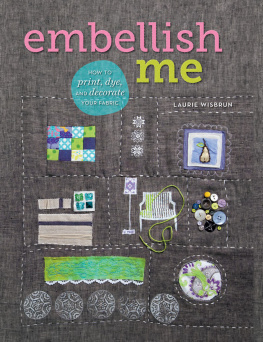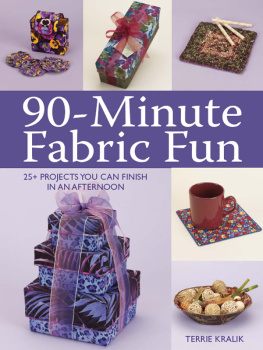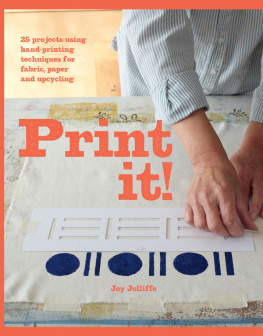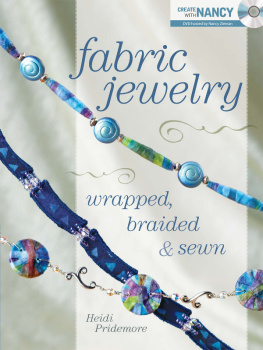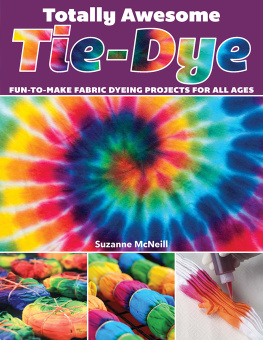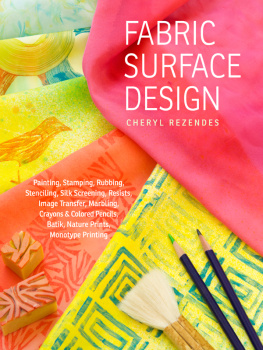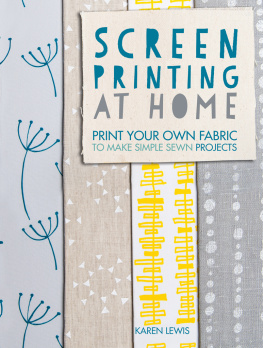EMBELLISH ME
How to Print, Dye, and Decorate Your Fabric
Laurie Wisbrun

INTRODUCTION
by Laurie Wisbrun

As you start to ponder the types of fabric you can alter, and all the goodies you can embellish, youll begin to recognize the possibilities as endless. I remember as a little girl, when I discovered paint pens, I took to personalizing everything I could get my hands on. As I ran out of fabric items to customize in my wardrobe and bedroom (handpainted shoes, jackets, and book bags were some of my favorites!), I started personalizing our household appliances. Handmade fabric tags covered with glitter and paint pen swirls suddenly began to appear on everything in our house plants, washing machine, refrigerator, dining table, the dog Nothing was off limits.
In the past, I thought the word embellished was somehow synonymous with gaudy and it brought to mind mounds of rhinestones and the bedazzled items of the 1970s. But as Ive gotten older and become more confident in my artistic voice, embellishment has turned into a way of making something more special and unique.
I love that, due to the nature of hand-decorated items, each piece is one of a kind. Weve all been in the midst of a project when you have the moment where youre convinced that with that one slip of the hand, youve just managed to destroy your creation. Those aarrgh, oh no! parts of a project where the pattern you envisioned in your head doesnt look much like what you ended up drawing with your pen. Or when you didnt quite get enough ink on the stamp and the coverage isnt quite as even as you had intended. But at the end of most of my projects I findmore often than notthat those little portions end up being my favorite elements of what I created. So, my advice to you is to celebrate the inconsistencies and little imperfections in what you create. Dont try to make it perfect. It can take all the fun out of the experimentation and the impromptu nature of creating something all your own.

Zippered pouch by Laurie Wisbrun. Features hand-dyed fabric with bleach-resist bird motif and machine-drawn embroidery. Appliqu and pieced portions incorporate hand screen-printed Hearts fabric by Umbrella Prints.
When I set out to write this book, I knew I wanted to develop a reference guide that featured an extensive number of approaches to embellishing. I wanted it to feature sophisticated and artistic approaches. With that in mind, I had my heart set on collaborating with some of my favorite artists so each of them could demonstrate their own unique spin on their featured techniques.
Each tutorial in this book will equip you with the information you need to experiment with the technique, leaving you with the freedom to apply the approach in your own way. Galleries and interviews with the chapter contributors feature beautiful examples of embellished items to further inspire your own creative vision. In the final chapter youll find interviews with cutting-edge artists who have taken embellishment to completely new levels and who have been gracious enough to share their insights into how they maintain inspiration, create collections, and market their artistic work.
I have loved creating this book and I hope it becomes a treasured new resource and a source of inspiration for you.

1
GETTING STARTED
by Laurie Wisbrun
Part of exploring embellishing is arming yourself with an array of tools and materials to allow you to experiment with different techniques. This chapter touches on some of the basic items you should have on hand, but dont limit your toolkit to just these items. It can be extremely satisfying to open your craft bins or drawers and find the perfect item to incorporate into your latest project, or that tool you were never sure if you would use. All those bits, bobs, and craft weapons youve been collecting are about to be put to great use.
TOOLS AND MATERIALS
Depending on what type of embellishing you plan to do, you may need a variety of tools and materials. These lists cover some of the goodies to keep in your toolkit.

General
- Pens, pencils, and sketch paper
- Tracing paper
- Graph paper
- Lightweight sheets of cardboard
- Adhesives (glue sticks, sprays, glue gun, jewelry epoxy)
- Ribbons, buttons, lace, and varied trims
- Zippers and fringe
- Trinkets and charms
- Beading needles (very fine in order to work with tiny bead holes)
- Beads of different sizes
- Paper ephemera (originally used to describe vintage paper but the rise in scrapbooking has led to a surge in reproduction paper items that have a vintage feel)

Cyanotype printing
- Ink-jet transparency film
- Cyanotype kit (with bottles)
- Soda ash (sodium carbonate)
- Tannic acid
- Sodium alginate thickener
- Dye-resist paste
- Hydrogen peroxide
- Picture frame (glass and backing)
- Plastic squeeze bottles
- Gloves
- Measuring cups and spoons
- Foam brush
- Plastic clips

Dyeing, bleaching, and painting
- Safety materials (gloves, goggles, mask, and dye box)
- Fabric dyes and paints (check manufacturer descriptions for the type best suited to the surface youre working on and the technique youre using)
- Permanent fabric pens, pencils, and chalks
- Salt (helps the fabric to absorb the dye, which helps create deeper colors)
- Urea (a moisture-drawing agent that keeps the fabric damper for longer during the dyeing process, resulting in deeper, brighter colors)
- Soda ash (a dye activator that fixes reactive dyes so they are permanent and do not wash out)
- Household bleach
- Bleach pen
- Anti-Chlor Neutralizer (stops the bleaching action of bleach)
- Stainless steel or enamel dye pot
- Natural dyestuff
- Alum and cream of tartar mordant (to prepare fabric for natural dyes)
- Non-corrosive pipe sections and string (for shibori)
- Soy wax
- Measuring spoons
- Non-corrosive stirring tools
- A variety of plastic containers
- Plastic squeeze bottles
- Mixing cups
- Natural bristle and sponge brushes
- Textile detergent (a pre- and post-wash detergent specially formulated for dyed fabric to reduce washout and fading)
- Iron and ironing board

